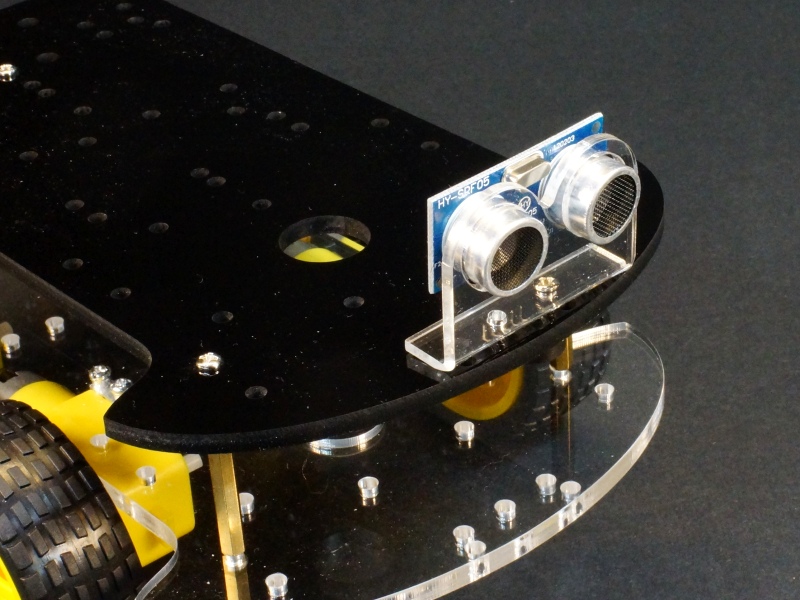

- #Mount frc ultrasonic sensor code
- #Mount frc ultrasonic sensor Pc
- #Mount frc ultrasonic sensor series
If you do this, be sure to cover all soldered joints with heatshrink. I used some old co-axial cable I had laying around. I needed to extend these, my tanks are 6 mtrs apart. Now plug the Sensors into the back of the sensor boards, they have 2 mtr long co-axial leads. LED Anode (long leg) to Arduino GPIO13 (D7) Through a resistor if desired The LED is only on for 50mS every 2 seconds so I didn't bother with a current limiting resistor but a 1/4W 470R resistor can be added if you wish. It's probably a good idea to take the supply and ground for the sensor boards from the DC-DC converter output pins when doing the final wiring in the box but for testing use the Arduino 3v3 and GND pins. This is good as level converters are not needed. Do not supply more than 5 volts to the VIN pin if you use that. They have a 5v input supply pin (VIN) and also run on the USB supply when connected to your PC. Be aware these ESP12E boards run on 3.3 volts. Plug the 2 ultrasound sensor boards directly into the breadboard and run 2 wires for each to the Arduino as below. A 12v supply could be used with these converters.
#Mount frc ultrasonic sensor Pc
So if you connect the sensor to the non-inverting input and connect the potentiometer to the inverting input, the output will be LOW whenever the sensor is activated.I used a breadboard for initial setup and testing.įor testing purposes this can run off the USB supply from your PC but in the field I used a small 3v3 regulated DC-DC converter supplied by a 9v plug pack. You can do this by switching the wires connected to the op-amp's input pins. Depending on what kind of circuit you want to activate, you may want the output to be a LOW signal instead. Then whenever the signal from the sensor drops below this reference voltage the output goes HIGH. The potentiometer sets the reference voltage for the sensor. This configuration of the op-amp functions as an adjustable comparator. Lastly connect the inverting input (marked as "-") to the signal wire from the sensor. Then connect the non-inverting input (marked as "+" to the center lead of the potentiometer. Connect the ground wire to the other side of the potentiometer and to the V- pin on the IC. Connect the 5V supply to one side of the potentiometer and to V+ pin on the IC. All you need is a 741 op-amp IC and a potentiometer (variable resistor). If you don't have an Arduino, you can use an op-amp (operational amplifier) to monitor the signal from the proximity sensor.
#Mount frc ultrasonic sensor code
Example Code int InputPin = 0 // analog pin 0 is the input pin int OutputPin = 1 // digital pin 1 is the output pin int val = 0 // variable to store the value read void setup() Here is an quick example of the code that you could use. When the voltage drops below a set threshold, the Arduino activates the your special effects. The AnalogRead function measures the voltage of the signal coming from the sensor. Then connect the signal wire from the sensor to an analog input pin on the Arduino. Connect the 5V wire from the sensor to either the 5V pin or a digital output pin set to HIGH. To do this, connect the ground terminal from the sensor to the GND pin on the Arduino.

In most cases you will use a microcontroller such as an Arduino to monitor the signal from the sensor. This also helps to make the sensor more directional. The most effective way to do this is to put a black piece of heat shrink tubing around the phototransistor. To ensure that only reflected light is detected by the phototransistor, it is important to add a light barrier between the LED and the phototransistor. I added three pins to connect the sensor to the signal processor. I soldered the sensor components together on a small piece of perf board. An additional wire is connected to the collector to act as an output pin for the sensor. The collector is wired to a 10 kohm resistor that is connected to 5V. The emitter of the phototransistor is connected to ground.
#Mount frc ultrasonic sensor series
Or you can use multiple LEDs in series to bring down the voltage across the resistor. You can use two 68 ohm resistors in parallel. If you don't have a resistor rated for that much. A 33 ohm resistor will experience about 1/2 watt if power. The closest resistor that I had above this value was a 33 ohm resistor. To find the appropriate resistor value for the LED use this formula: Resistor Value = (Supply Voltage - LED Voltage) / LED Current. The IR LED is connected to the 5V supply with a 33 ohm series resistor.


 0 kommentar(er)
0 kommentar(er)
